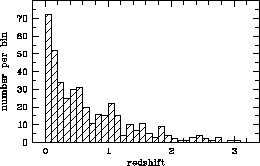Quasar Surveys in Hamburg

Scientific Goals
- compile samples of high-redshift (1.5 < z < 3.2),
bright QSOs suited for high-resolution spectroscopy
(e.g., for the ESO-VLT);
- provide targets for ultraviolet spectroscopy with HST;
- discover new gravitationally lensed systems;
- construct large flux-limited and bias-free samples of bright
low-redshift QSOs and Seyferts for host galaxy studies;
- determine the local luminosity function of QSOs and
Seyfert 1 nuclei;
- study the evolution of the most luminous part of the QSO population.
Survey Requirements:
- cover substantial fraction of entire sky;
- achieve high throughput and
- high QSO selection efficiency.
Survey Technique
Technical data:
- Unwidened and unfiltered objective prism spectra
- Kodak IIIa-J photographic emulsion
- Spectral range: 3200-5400 Å
- Approximate magnitude range 13 < B < 18 (depends on seeing and plate quality)
Digitisation and extraction of spectra
For each survey field at least two photographic plates are
required: A direct plate where objects can be accurately located,
and a spectral plate, obtained with objective prism to disperse
each object into a slitless spectrum on the plate.
Upon arrival in Hamburg, plates taken with the Calar Alto and ESO
Schmidt telescopes are digitised with the
Hamburg PDS machine.
The details of the digitisation mode
(scanning speed, aperture and step size etc.)
depend on the particular application.
Example
Small section from the Digitized Sky Survey:

In this image there are several starlike objects in the
magnitude range B = 12-20, and a small group of galaxies on
the left. The section covers 8???? x 3???? mm on the Schmidt plate,
or ???? x ???? arcmin in the sky.
The same sky area in the corresponding spectral image:

Each object brighter than B=18 has produced a spectrum
on the plate, ranging from 5400 Å (left end)
to 3200 Å at the right end, respectively. Most of
the galaxies have very fuzzy images and so make only fuzzy
and short spectra, implying that they are very red.
However, one bright galaxy shows a sharp and exceptionally blue
spectrum, typical for a low-redshift Seyfert 1 galaxy.
By establishing a precise astrometric transformation from direct
to spectral plate it is possible to
extract one-dimensional spectra for all detected objects. The
above located Seyfert galaxy looks now like this:

The ordinate gives photographic density above diffuse sky background in
integer units (800 units correspond to one density step).
The wavelength scale is nonlinear because of the objective
prism which has a nonlinear dispersion relation.
There are several emission lines in the spectrum, allowing to
estimate the redshift of the galaxy: z = 0.032.
Further examples of digital objective prism spectra: ...
Survey Projects
Hamburg Quasar Survey (HQS):
- Schmidt telescope on Calar Alto, Spain
- Dispersion 1390 Å/mm
- Initiated in 1984, wide-angle search started in 1988
- Aim at full coverage of Northern Extragalactic Sky
δ > 0° |b| > 20° →
567 Schmidt fields, or ∼ 11 000 deg2
Hamburg/ESO survey (HES):
- ESO Schmidt on La Silla, Chile
- Dispersion 450 Å/mm
- ESO key programme since 1990
- 428 Schmidt fields with $delta; < +2.°5 and
E(B-V) < 0.15 → ∼ 9000 deg2
QSO Selection Strategy
(based on database of digitised spectra)
1. Search for
- UV excess spectra;
- objects with ``blue'' continuum slopes;
- emission line objects;
- spectra with continuum breaks;
- generally ``peculiar'' spectra.
2. Separate stellar contamination from absorption lines
3. Snapshot slit spectroscopy of high-grade candidates
Calar Alto 2.2 m
ESO 1.52 m and 1.54 m Danish
4. For bright high-redshift QSOs: follow-up with IUE
Basic Properties
-
ESO key programme since 1990;
-
based on objective prism spectra taken with ESO Schmidt;
-
Digitisation with Hamburg PDS microdensitometer;
-
Magnitude range: 13 < B < 18;
-
aims at complete coverage of southern extragalactic sky:
9000 deg² = 375 ESO fields.
More Properties
-
Candidate selection with multitude of selection criteria
-
Limiting magnitude: B < 18-18.5 (detection limit);
B < 17-17.5 (completeness limit)
-
Efficient removal of stellar contamination because of
high spectral resolution: ∼ 15 Å at Hγ.
(Spin-off: Many interesting stars discovered!)
-
Success rate of 70 % for quasars in follow-up spectroscopy,
without sacrifices in completeness.
Current status
-
Plates exist for all fields.
-
Plates for 345 ESO fields are digitised & reduced.
-
Follow-up complete for 336 fields:
∼ 1400 QSOs with B < 18 (∼ 700 newly discovered)
-
New flux-limited sample of 415 QSOs with B < 17
in effective area of 3700 deg²
(see here for the
redshift histogram )

→ Largest existing sample of bright QSOs.
-
Surface density of QSOs is consistent with or higher than
in other surveys.
-
Survey will be completed by mid-1999.
 Last modified 21.01.1999 by
L. Wisotzki
Last modified 21.01.1999 by
L. Wisotzki





 Last modified 21.01.1999 by
Last modified 21.01.1999 by